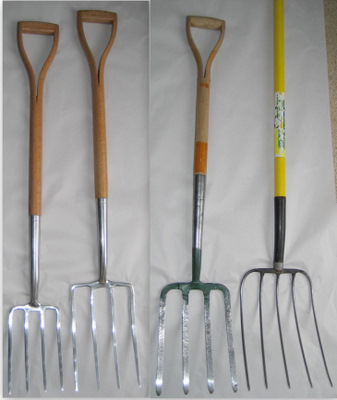Border Digging Spading Manure
Fork Fork Fork Fork
I’m surprised at how few people in the general population of gardeners truly know how useful a good fork can be. Doing all your digging using a spade or shovel is often not the best way to approach the task.
For most garden and landscape tasks that require breaking or cutting earth, a fork is the better tool to choose. In actuality, for many gardening and landscaping jobs you really need both a fork and a spade or shovel. In tandem they make the work a lot easier.
Breaking new ground or cleaning out a gone-to-weed piece of earth? Start with a fork. Cutting dense weeds or even packed turf is much easier than trying to do it with a spade. Forks penetrate the soil with much less resistance. The downward force you put on the tool is concentrated into four tines and not along the entire leading edge that a shovel or spade offers. Less resistance translates to deeper, easier soil cutting.
Use a fork for heavy duty weeding. A spade or shovel is mostly useless as a weeding tool. You’ll find a fork most valuable in removing larger clumps of plants. If you have the room to get a fork into the weeds without disturbing your good plants, weeding with a hand tool, like our CobraHead Weeder, is always easier if you first break the soil and loosen the roots with a fork.
Transplanting can be easier with a fork, but this is often a task where a fork and spade working in tandem can accomplish much more than trying to do the job with one tool or the other.
It’s much easier and more effective to break and loosen soil with a fork. A fork can be used to loosen soil without “turning it over” and inverting soil strata. Maintaining soil structure without intense tilling is beneficial to soil health.
If you have to move a pile of loose material the shovel always wins, but if the pile is packed hard it’s far easier to soften it up with a fork, then scoop it away with the shovel.
Forks come in a great variety of styles and quality, but most “garden” forks can be grouped as follows:
Digging forks have four sharp, usually square tines. Most often digging forks have a “D” handle, but there are longer handled versions.
Similar to a digging fork, a spading fork has wider, flatter tines. It’s better than a digging fork for moving soil material, or edging.
A border fork is a smaller, lighter digging fork. It used to be called a “ladies fork”, but it is a tool for all gardeners. It is much better for weeding and better for a lot of edging tasks than the wider digging fork. I find this fork the most valuable for cleaning up overgrown areas. Its light weight and maneuverability in tight areas make it a pleasure to use.
Larger forks, called broad forks, but also sold as bio-forks and u-bars, are used to aerate larger beds and are often used by small scale commercial growers. They are nice tools to have if you’re a vegetable grower, but you can use a digging fork or spading fork to accomplish the task.
Garden forks are not pitch forks. Pitch fork is a nebulous term used to describe just about any fork, but it refers mostly to the thinner round-tined forks used, obviously, to “pitch” material. Hay forks and manure forks would fall into the category of pitch forks. A good manure fork is usually a better tool for moving and turning compost than a garden fork. It’s lighter and will lift more material. Most gardeners would not need a hay fork, which typically has three tines spaced widely apart. The tines of pitch forks are not meant for digging and will most likely bend or break if used for that purpose.
As far as using the fork goes, most of the same rules apply as with other tools. Safety first. Forks have exceptionally sharp tines and an accidental thrust in the wrong direction or even dropping it on one’s foot can result in a nasty injury.
Don’t work too hard. Breaking dense soil is hard work. Take small bites with the fork when the soil is hard. To work a fork into hard ground, rock it side-to-side instead of back and forth. Work with tough soled work shoes. Working in sneakers, sandals, or flip-flops is not smart. You have no protection on top, and you can do damage to your arches by stepping on the fork with soft soled shoes. Keep the fork clean during and after use. Caked on mud can really inhibit the ability of the fork to penetrate hard soils.
Even the best forks can be broken if you put the entire weight of your body on them. While better forks are quite strong, they are not made to replace the work that might be better done by a mattock or some of the very heavy duty ground breaking tools that are out there. A good garden fork is light and well balanced and there is always a trade off for lightness versus brute strength. Your common sense should tell you if you are trying to work your fork too hard.
Good forks are invaluable. Better forks cost more, but the cheap ones will break easily and do not have good ground cutting capability. As with most garden tools, you really do get what you pay for, so research your purchase before you buy.

